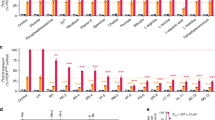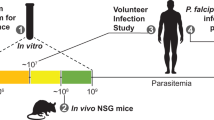Abstract
THE appearance of strains of human falciparum malaria resistant to chloroquine1 has stimulated investigations on the mode of action of this drug and on the mechanism of resistance to it. Although no morphological differences have been described between chloroquine-resistant and ordinary Plasmodium falciparum, a striking difference was observed in the mouse malaria P. berghei; in the resistant strain, pigment (haemozoin) was not visible by light microscopy, and even with the electron microscope only a few minute grains of pigment-like material could be detected2. This finding and the hypothesis advanced independently by Schueler and Cantrell3 and Cohen et al.4, that the binding of chloroquine by ferrihaemic acid might account for chloroquine resistance, direct attention to haemoglobin digestion and its waste product haemozoin as being possibly of significance in both the mode of action of chloroquine and in resistance to it.
This is a preview of subscription content, access via your institution
Access options
Subscribe to this journal
Receive 51 print issues and online access
$199.00 per year
only $3.90 per issue
Buy this article
- Purchase on Springer Link
- Instant access to full article PDF
Prices may be subject to local taxes which are calculated during checkout
Similar content being viewed by others
References
Young, M. D., and Moore, D. V., Amer. J. Trop. Med. and Hyg., 10, 317 (1961). Degowin, R. L., and Powell, R. D., Amer. J. Trop. Med. and Hyg., 14, 519 (1965).
Peters, W., Nature, 203, 1290 (1964). Peters, W., Fletcher, K. A., and Stäubli, W., Ann. Trop. Med. and Parasit., 59, 126 (1965).
Schueler, F. W., and Cantrell, W. F., J. Pharmacol. Exp. Therap., 143, 278 (1963).
Cohen, S. N., Phifer, K. O., and Yielding, K. L., Nature, 202, 805 (1964).
Deegan, T., and Maegraith, B. G., Ann. Trop. Med. and Parasit., 50, 194 (1956).
Sherman, I. W., and Hull, R. W., J. Protozool., 7, 409 (1960).
Lemberg, R., and Legge, J. W., Hematin Compounds and Bile Pigments (Interscience, 1949).
Fieser, L. S., and Fieser, M., Organic Chemistry (Rheinhold, 1956).
Bentley, K. W., The Natural Pigments (Interscience, 1960).
Moulder, J., and Evans, jun., E. A., J. Biol. Chem., 164, 145 (1946).
Drabkin, D. L., Arch. Biochem., Biophys., 21, 224 (1949).
Anson, M. L., and Mirsky, A. E., J. Gen. Physiol., 13, 469 (1929–30).
Fulton, J. D., and Grant, P. T., Biochem. J., 63, 274 (1956).
Author information
Authors and Affiliations
Rights and permissions
About this article
Cite this article
SHERMAN, I., MUDD, J. & TRAGER, W. Chloroquine Resistance and the Nature of Malarial Pigment. Nature 208, 691–693 (1965). https://doi.org/10.1038/208691a0
Issue Date:
DOI: https://doi.org/10.1038/208691a0
Comments
By submitting a comment you agree to abide by our Terms and Community Guidelines. If you find something abusive or that does not comply with our terms or guidelines please flag it as inappropriate.



